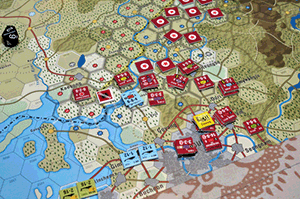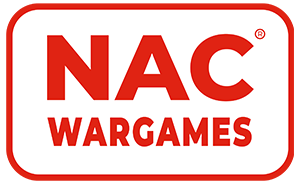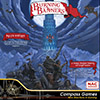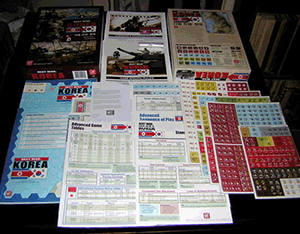Next War: Korea 2nd PrintingSixty years of tense, uneasy peace are shattered as the Korean Peninsula erupts in renewed warfare. One historically, ethnically, and culturally homogeneous people polarized and separated by superpower politics and economics hurl men, weapons, and material into the maelstrom of modern combat in an attempt to settle their arbitrary division once and for all.
From Pyongyang in North Korea to Busan in the South, the war rages. In a scene reminiscent of the first attack by the In Min Gun in 1950, the North Korean People�s Army surges across the Demilitarized Zone and penetrates deep into South Korea.
Special Operations Forces from both sides conduct raids, interdiction, and reconnaissance missions behind enemy lines while airborne, air assault, and amphibious forces strike far behind those lines attempting to outflank the main army forces of both sides. In the air, both sides wage a heated campaign in an effort to establish superiority over the skies of Korea. With rough terrain and the full ferocity of modern armor, airmobile, airborne, and marine warfighting capabilities, there is no safe haven in the lethal cauldron of battle which has engulfed the Korean Peninsula.
While North and South battle for a quick, decisive victory, the world awaits the response of the two military superpowers in the region: the United States of America and the People�s Republic of China. Will the United States, stung by high casualties among the soldiers of its 2nd Infantry Division near the DMZ during the surprise artillery barrages and initial assaults on the first day of the war, be able to reinforce the South quickly enough, and, if so, how and in what strength? Will the Communist Chinese again react (or pre-emptively intervene) to a massive US response and join the fray, thus widening the conflict? As the situation evolves, choices are made, forces are committed, and the security of Japan and the future of the two Koreas hangs in the balance.
Next War: Korea, the first of a planned series of Next War games, allows players to fight a near future war on the Korean peninsula. In this updated and improved version of the previously-released Crisis: Korea 1995, players have access to virtually all military assets of North and South Korea, as well as large forces from the USA and the PRC. The integrated, easy to learn air-land combat system allows for unit efficiency, armor effects, light infantry, attack helicopters, Close Air Support, Cruise Missiles, and the particularly tough terrain of Korea.
 |
Make no mistake: Next War: Korea is not an Introductory wargame. Rather, we have intended herein to create a system (and a series) that will allow detailed study of modern warfare in various venues as well as engaging gameplay. That said, the Standard Game rules encompass a fairly straightforward ruleset that will, we think, be considered pretty "easy to learn" by experienced wargamers. So players who choose to play Standard Game scenarios can have a relatively quick game when that�s what suits them. The real flavor of a war in the theatre, though, comes through in the Advanced Game, where you get much more control over airpower and can more clearly see each side�s strengths and weaknesses. For players who want a "mini-monster game" experience, playing the Advanced Game Campaign Scenarios with some or all of the optional rules will definitely "deliver."
So our hope is that we have created a game with enough variety and scaling of complexity that you can find an engaging and maybe even enlightening experience whether you want to play a fast two-player game, a longer monster game, or an ongoing solitaire study. We intend to provide tools for online game play as well (a Vassal module is being created now for use during playtesting) so that this game can be played in either real-time or over longer periods on the internet.
UnitsGround units in Next War: Korea represent primarily divisions and brigades of armies of North and South Korea, The United States and her Allies, and the People�s Republic of China. All ground units are rated for their attack and defense strengths, movement capabilities, and unit efficiency.
Air units represent fighter, bomber, and attack squadrons of the major combatants and are rated for All-Weather Capabilities as well as their range, average pilot skill, and their abilities in Air-to-Air Combat, Close Air Support, and Strike missions.
Naval units and capabilities are abstracted somewhat in the Next War series. A "Sea Control" mechanism reflects the results of the surface and sub-surface battles, while the game�s naval unit counters represent the major Aircraft Carrier Battle Groups and Amphibious Ready Groups of the US Navy. Additional amphibious capabilities are represented by the Special Forces capabilities of each side.
Maps and TerrainThe game�s two maps present a portion of modern-day Korea at a scale of roughly 7.5 miles per hex. The maps cover the entire peninsula east-to-west and stretch from about 30 miles north of Pyongyang in the North to Taegu in the south. Hexes are larger than the standard 1/2" hex found in Crisis Korea: 1995, allowing us to use larger 9/16" counters in this game and make it a bit easier for players to move game pieces in the congested areas around the DMZ.
Game SystemAs in Crisis: Korea 1995, there are two types of game turns: Initiative turns (longer turns where the side with the Initiative has more opportunities to move and attack) and Contested turns (shorter turns where neither side has the initiative but each is trying to muster the resources to regain the initiative). Thus the inherent "initiative player advantage" built into the game system incents each player to always be thinking about how to seize and maintain the battlefield initiative.
A Standard game turn is composed of:
Weather Determination. Bad weather can severaly hamper air and naval operations activity and can significantly slow ground operations.
Initiative Determination
an Air/Naval Phase, wherein air superiority levels and air availability are determined and Sea Control is established or modified.
One or more Movement and Combat Phases that allow both sides to move, react, and fight, with an advantage to the Initiative player on non-Contested turns
Arrival of Reinforcements and Replacements
Victory Determination
Combat resolution examines not only unit strengths but also unit efficiency (representing training, doctrine, and morale), as well as the terrain where the combat takes place. The CRT tends to be very bloody, reflecting both what we believe will be a degree of attritional warfare early on in light of the massive artillery concentrations near the DMZ as well as the lethality of modern weapons. As in many games, casualties represent not only actual combat losses, but also losses of unit cohesion brought about by the rapidity and pace with which modern armies are able to engage and exploit on the battlefield.
ScenariosThere are several Standard Game scenarios. The first three one mappers, "Seoul Train," "Uijong Blues," and "East Coast Highway" (North Map only) cover the first week of the war by dividing the DMZ into roughly three equal sections. These focus on the initial assaults to break the South Korean lines and introduce players to the basic mechanics of the system, while giving them insight into attack and defense strategies for the "big game." Players can also play the entire DMZ front scenario, "Militarized Zone," (North Map only) for the first week (basically, combining the three scenarios above). In addition, players can add the South Map and play the entire Standard Campaign game, "All In." Two other scenarios are provided which examine the U.S. Amphibious landing. "Inchon Again" and the battle for Taejon, "Spearhead." In addition, a scenario, "They Did What?" is provided for players to experiement with a South Korean attack on North Korea without, however, the help of the United States.
The Advanced Game Scenarios come in three flavors � la NATO: The Next War in Europe: Strategic Surprise, Tactical Surprise, and Extended Buildup. This offers the players the ability to game out a variety of "At Start" war scenarios based on varying levels of readiness.
There is also an International Posture Matrix � la Flashpoint: Golan to allow players to experiment with a variety of intervention options for the non-Korean players in the region.
Notes for Players of Crisis: Korea 1995The Next War series is heavily based on the base system and rules pioneered in Crisis: Korea 1995, modified and enhanced based on additional testing and development over the past 15+ years. For Crisis: Korea 1995 veterans, changes from the original system include:
Standard Game changes
Primary change is to split the rules into three books: Standard Game, Advanced Game, and Game Specific Rules.
The map portrays an area roughly 150 miles north and 250 miles south of the DMZ. Hex scale remains the same at 7.5 miles per hex, but the hexes are larger to accommodate the 9/16" counters.
Sides are indicated as having Limited or No All-Weather capability in the Game Specific Rules (GSRs). This affects the number of Air Points received in the Standard Game.
Sea Control has changed a bit with the Introduction of an In Shore box to go along with the At Sea box. There are specific rules governing where you can and can�t move with respect to the boxes, all-sea hexes, and ports. In addition, the Naval Movement rules were updated somewhat to reflect some changes in the ability to make a Contested Move through a non-friendly sea area.
Ground unit stacking has changed to allow over-stacking; however, there are some fairly severe penalties for doing so around attack, defense, movement, and Efficiency Ratings.
The Elite Reaction Movement segment has been altered slightly to only allow those Elite units not in an enemy ZOC to move.
Fortification hexes were split out from DMZ hexes. In other words, the DMZ hexes are a type of Fortification hex. Their effects remain essentially unchanged except that a DMZ hex offers a +1 DRM to the defender in combat.
Airmobile and Paradropped units may attempt to Advance into a City, Urban, or Installation hex if they survive their transport.
Attackers convert any extra remainder from the odds ratio calculation into a -1 DRM. This also applies if the odds ratio is greater than the maximum (i.e., 8:1 is as high as the CRT goes; if the attacker generates a 9:1 combat, he receives a -1 DRM).
The odds column is set strictly on the strength ratio. Column shifts are then calculated from that point.
Light Infantry provides a +1 DRM in defense to go along with its -1 DRM in attack (in those certain terrain types).
Units rolling to avoid a retreat either lose a step to stay or retreat if they fail.
Advance/Control checks have been replaced with Clearing Operations, a new mechanic for occupying and controlling City, Urban, and Installation hexes.
Advanced Game changes:
In the Air Superiority step, the number of destroyed, struck, or captured airfields has an effect on the number of aircraft which can be allocated to the Air Superiority box.
There are now 2 Special Forces phases, one of which is only available if it is an Initiative turn.
Special Forces are no longer tracked as points, but as counters which roll for recovery or elimination.
HQs can provide Chemical Weapons support by GSR.
Emergency Resupply has been tweaked slightly to limit its general use.
Isolation has been tweaked slightly to differentiate it more from Out of Supply.
The exception for Airborne units after a Paradrop to being isolated has been expanded to include Air Assault and Marine (only) Amphibious units.
A new mission is allowed for both Special Forces and Air Strikes: Interdiction. Depending on terrain, etc. such a strike can interdict road movement and increase off-road movement cost.
Strike Results now reduce a unit�s Efficiency Rating by the Strike Result.
A UN Resolution mechanic has been introduced with VP penalties for ignoring a Cease Fire which is not Vetoed.
Game (Korea) Specific Rules
NKPA Light Infantry is not eliminated on a failure to infiltrate. Instead, it is placed in its hex of origin with a Strike marker depending on how badly it failed.
Some NKPA Artillery Brigades are physically represented on the map to highlight the massive reliance on them for the initial attack. These units provide a single combat shift similar to HQs.
The U.S. Marines have several lower-level HQs which are slightly less functional than regular HQs.
The U.S. OoB reflects the Brigade Combat Team (BCT) organization in that any BCT is, nominally, subordinate to any U.S. Army HQ.
There are some altered, detrimental penalties for multi-national stacking.
There are rules governing the off-map boxes (Pusan and Hamhung/Hungnam) and movement along the off-map movement lines.
Optional Rules
Air Cushion Vehicles are now an optional rule.
In Next War: Korea, the Korean Peninsula is on fire with two of the world�s most well-prepared, antagonistic forces arrayed against each other. Can you, as the North Korean People�s Army commander, conquer the South in 3 weeks before the full might of the U.S. can be brought to bear? Can you, as the Republic of Korea�s Army commander, hold out against the renewed Communist assault until help arrives? And what will China do? There�s only one way to find out�
Disponible la traducci�n al Espa�ol de las Reglas Generales, Espec�ficas y Tablas

 Comprando este juego podrás ganar OcaPoints.
Comprando este juego podrás ganar OcaPoints. 





























